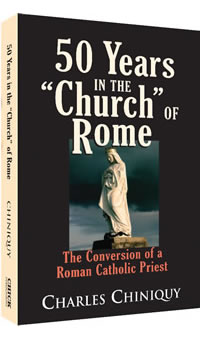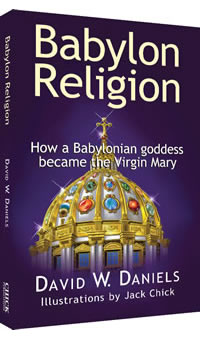Unholy Mother of Intolerance: The Inquisition
by Avro Manhattan
If Hitler should return and proclaim deep love for the Jews; or Stalin appear and declare himself a Capitalist, would we not take them with a largish pinch of salt? Well, then! Why should we react differently to a similar "phoney" conversion of an institution which has surpassed the evil of both these dictators?
Today the Catholic church claims heartfelt love for all those outside her. This is as incongruous as the claims of a repentant Hitler or Stalin. Indeed it would be laughably ridiculous if we were not dealing with tragic matters.
Her sudden desire to "embrace the separated brethren" is nothing but her latest device to make people forget the basic spirit of intolerance and fanaticism. That spirit is as alive as ever, ready to strike should the opportunity present itself.
All her actions in past centuries speak of nothing else. Her main excuse for intolerance makes strange logic: She is specifically charged by God to save the souls of all Christians. Since the killing of souls was worse than the killing of bodies, she reasoned, and since heretics used their bodies to kill souls, their bodies should pay for the sins of the wicked souls they housed.
Thanks to this Catholic logic, soon the ecclesiastical and temporal machineries of the Western world were enriched with the noble practice of judicial torture, expressly employed by Holy Mother Church for the suppression of heresy, later known as Protestantism.
In 1252 Pope Innocent IV issued Bull AS EXTIRPANDA. It became the classic in inquisitorial procedure. It provides:
1. that anyone may seize a heretic and despoil him of his property;
2. that every magistrate shall appoint an inquisitorial commission, whose salaries are to be paid by the State;
3. that no law may be passed interfering with these Inquisitors;
4. that heretics who will not confess their heresy shall be tortured;
5. that the confiscated property of heretics shall be thus divided: one-third to the Inquisitors and the bishops, one-third to the city, and one-third to those who aided in the arrest and conviction.
Pope Innocent gave precise instructions to all Inquisitors to enforce the regulations throughout Europe. Eventually it was made Statute Law. The regular clergy proved reluctant, so the popes turned to the most fanatical, intolerant and narrow-minded section of the Church structure, the sundry monastic orders.
The two which excelled in their infamous task were the Dominicans and the Franciscans. Armed with practically unlimited power from the popes, these Inquisitors swarmed all over Europe like theological hornets, setting up tribunals wherever they appeared.
Soon individuals, communities, nations, and indeed, the very hierarchy trembled at the mere mention of their names. Wherever they came, denunciations, accusation, treachery, perjury, torture, woe, and death resulted.
The hooded Inquisitors did not content themselves with establishing their court in the sundry lands of Europe. Pope Gregory IX appointed a Dominican Grand Inquisitor for the whole of Armenia and Russia. Pope Urban VI ordered the General of the Dominicans to appoint Inquisitors for Armenia, Greece and Tartary (China).
Pope Nicholas IV asked the Patriarch of Jerusalem to create Inquisitors from the mendicant friars in his land. Pope Gregory XI granted authority to the Franciscan Provincial in the Holy Land to act as Chief Inquisitor in Syria, Palestine and even Egypt.
When an Inquisitor arrived everybody was commanded, in obedience to the pope and to Mother Church, to disclose the name of anyone suspected of the slightest deviation from the Faith. The Inquisitors issued a compelling threat and a promise. A denouncer would get an indulgence of three years. Those avoiding their duty would be excommunicated.
Some denunciations were factual but many were concocted by vengeance, spite of jealousy. Those denounced, even on the flimsiest accusation or mere suspicion, would be arrested and flung directly into prison.
This usually was a common dungeon. Cold and damp, it lacked light or sanitation, and contained cut-throats, thieves, and the like. Among these the friars would plant spies to induce the accused, by pretended friendship, threats, or other methods, to admit his guilt.
If this first step proved insufficient, the suspected heretic would be chained with heavy irons and left to starve in a dark, foul hole called the durus carcer--"cruel prison." The accused was then brought before the inquisitorial tribunal composed of friars. If he asked the names of his accusers, he was told that only his judges had the right to know their names. He had no such right.
He was asked to confess to his guilt. If he pleaded innocence, he would be sent back to prison. On a second or third appearance before the Court, if he persisted he was put to torture. The whole purpose of his trial, of course, was to force a confession of heresy.
Torture was inflicted without solid proof of guilt. Two complainers or even one single accuser was sufficient for subjection to the agonies of torture, even if the accused man had, until then, been of unblemished character, pristine honesty and genuine piety.
The methods, kinds and degrees of torture were endless. The three basic ones employed were hoisting the man to the ceiling by his hands tied behind his back, breaking him on the rack, or greasing his feet and thrusting them into the fire.
If, following all the exquisite devices of torture, the heretic refused to recant or to admit his guilt, then the Inquisitors would pass capital sentence of heresy. Having done that, they would hand him over to the "secular arm," the civil authorities.
To complete the macabre farce, the Holy Inquisitors would ask these same temporal powers, in the name of the Church, not to kill the poor accused. This formality was a mere legalistic device to make the Church appear innocent of the blood which was about to be spilled--or rather, burned.
The civil authorities could not heed this hypocritical plea, however, lest the Holy Inquisition fall upon them. Refusal to burn the heretic would have placed the temporal authorities themselves on trial for their lives. For heresy, of course!
Soon no one was safe from potential arrest. The spying, denunciation, and hunting down of heretics reached cleric or lay, men or women, noble or common. No one was immune from the terrorizing omnipresence of the Holy Inquisition.
This reign of Catholic terror lasted for centuries. Hundreds of thousands of men, women, and yes, even children were murdered...burned alive at the stake. Simply because they dared to disagree with the Holy Catholic Church or with her popes.
This Catholic terror officially ended less than two hundred years ago. As recently as 1762 a Protestant pastor was condemned to death in France. Why? Simply because he was a Protestant! By whom? By the Catholic Church! Yes, by that same church which now pretends to love her "dear separated brethren."
Indeed, in Europe torture was still enforced by all the Tribunals of the Holy Inquisition until the last century, the pope being forced to abolish it only in 1816.
It was Napoleon, who entered Madrid in 1808, who was to abolish the Inquisition. When the Spanish Parliament in 1813 declared it incompatible with the Constitution, the Vatican protested. Super-Catholic Ferdinand VII restored it in 1814, with the full approval of the Church. The Holy Inquisition was finally suppressed by the Liberals in July, 1834.
Yes, SUPPRESSED. Was not this same spirit still alive in Croatia in 1942 when the Catholic Ustachi mutilated hundreds of thousands of Serbian "heretics?" Or in South Vietnam in 1960 when Catholic President Diem set out to rid that country of Buddhist "heretics?" Or in 1983 when Christmas shoppers in Protestant ("heretic") London were blasted into eternity by a Catholic IRA terrorist bomb in a crowded department store?
So the Office of the Holy Inquisition was abolished only as recently as last century. Let us never forget that the Catholic Church was forced to abolish it by a lay government. Yet it is still alive, a roaring lion gnashing at his cage bars still seeking whom he may devour.
- See more articles on related topics:
- Catholicism
- Inquisition
- Avro Manhattan
Other Articles from January/February 1984:
More on Catholicism:
Products of Interest:
-

50 Years in the Church of Rome
368 pages
This classic work shows how this priest began to question Catholic teachings until he became saved, and led his entire parish to salvation. -

Alberto
32-PAGE, FULL COLOR COMIC BOOK - Alberto Series Part 1 - Here is how Alberto, as a Jesuit, helped destroy churches and ministries. But as he read the Scriptures, he saw that Catholicism couldn’t save.
-

Godfathers, The
32-PAGE, FULL COLOR COMIC BOOK- Alberto Series Part 3 - Here’s how the Roman Catholic Institution, as the "Mother of Abominations" (Rev. 17), caused many wars. This is the book the Catholic press is afraid to mention.
-

Babylon Religion
224 pages
Learn how a Babylonian goddess became the Virgin Mary. An easy-to-read history of Catholicism's Babylonian origin.



